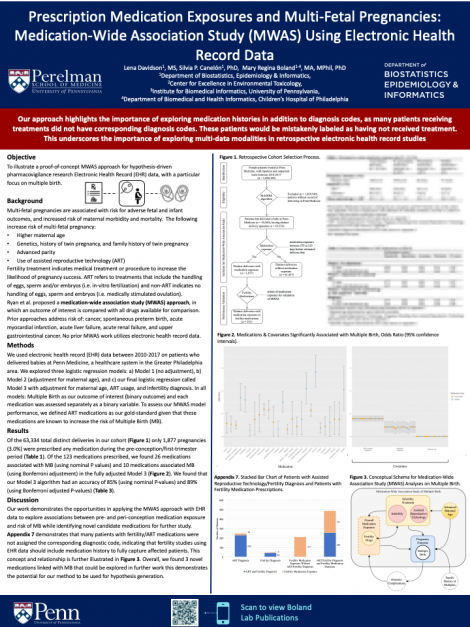Lena Davidson
Prescription Medication Exposures and Multiple Gestation Pregnancies: Medication-Wide Association Study (MWAS) Using Electronic Health Record Data
Abstract
Background: Medication-wide association study (MWAS) approach has been applied to observe prescription use and cancer risk, spontaneous preterm birth, acute myocardial infarction, acute liver failure, acute renal failure, and upper gastrointestinal ulcer. Current literature on medication use and association with multiple birth (e.g. monozygotic, dizygotic) often depend on assisted reproductive technology (ART) cohorts. Genetic factors, demographics, environmental exposures, assisted reproductive technology and other factors may contribute to the development of a multi-fetal pregnancy.
Objective: We aim to present methodology to systematically explore potential associations between medications prescribed during the pre-conception/first trimester period and occurrence of multiple birth (e.g., twins, triplets) in patients who delivered at Penn Medicine.
Materials and Methods: We used electronic health record (EHR) data between 2010-2017 on patients who delivered babies at Penn Medicine, a healthcare system in Philadelphia and the Greater Philadelphia area. We explored three logistic regression models: a) Model 1 (no adjustment), b) Model 2 (adjustment for maternal age), and our final logistic regression c) Model 3 was calculated with multiple birth as our outcome of interest (binary outcome) and each medication as a binary variable while adjusting for maternal age, ART, and infertility diagnosis codes. Defined ART medications were used as our gold-standard of medications to evaluate MWAS performance.
Results: Of the 63,334 total distinct deliveries in our cohort. 1,877 pregnancies (3.0%) were prescribed at least one medication during the pre-conception/first-trimester period. Of the 123 medications prescribed, we found 26 medications associated with MB (using nominal P values) and 10 medications associated MB (using Bonferroni adjustment) in the fully adjusted Model 3. We found that our Model 3 algorithm had an accuracy of 85% (using nominal P-values) and 89% (using Bonferroni adjusted P-values).
Conclusions: Our work demonstrates the opportunities in applying the MWAS approach with EHR data to explore known associations with MB while identifying novel candidate medications for further study. Some of these medications are known ART-related medications, but diagnosis of infertility or ART usage was often missing from the EHR necessitating use of MWAS for MB to uncover these associations. Overall, we found 3 novel medications linked with MB that could be explored in further work.
Keywords
pregnancy; pregnancy, multiple; assisted reproductive technique; electronic health recordAbout Us
To understand health and disease today, we need new thinking and novel science —the kind we create when multiple disciplines work together from the ground up. That is why this department has put forward a bold vision in population-health science: a single academic home for biostatistics, epidemiology and informatics.
© 2023 Trustees of the University of Pennsylvania. All rights reserved.. | Disclaimer




Comments